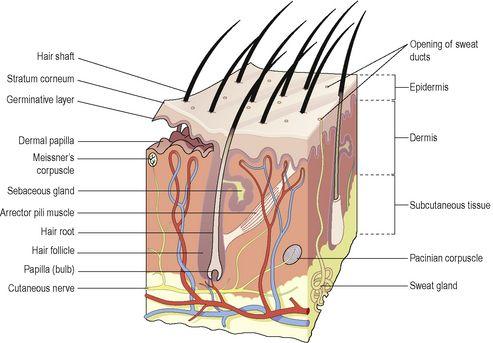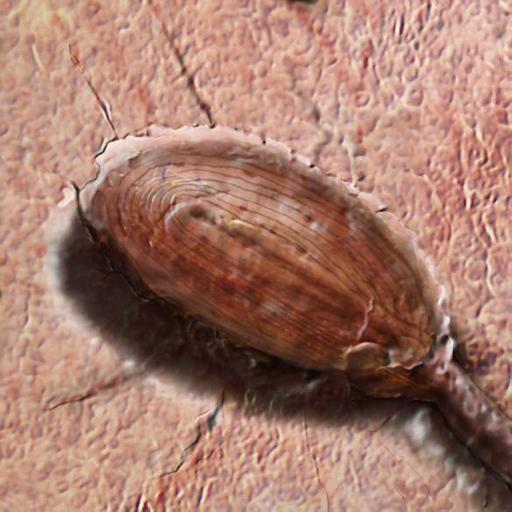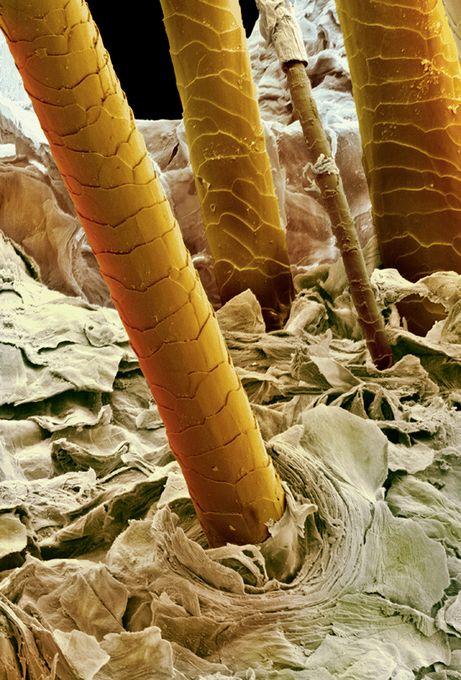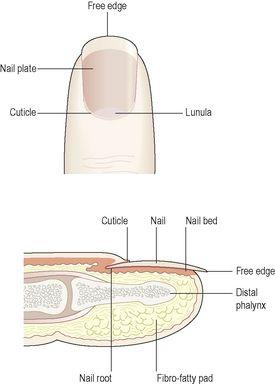Ross & Wilson Anatomy and Physiology in Health and Illness (167 page)
Read Ross & Wilson Anatomy and Physiology in Health and Illness Online
Authors: Anne Waugh,Allison Grant
Tags: #Medical, #Nursing, #General, #Anatomy

•
desquamation (shedding) of the keratinised cells from the surface
•
effective keratinisation of the cells approaching the surface
•
continual cell division in the deeper layers with newly formed cells being pushed to the surface.
Hairs, secretions from sebaceous glands and ducts of sweat glands pass through the epidermis to reach the surface (see
Fig. 14.4
).
The surface of the epidermis is ridged by projections of cells in the dermis called
papillae
(
Fig. 14.2
). The pattern of ridges on the fingertips is unique to every individual and the impression made by them is the ‘fingerprint’. The downward projections of the germinative layer between the papillae are believed to aid nutrition of epidermal cells and stabilise the two layers, preventing damage due to shearing forces.
Blisters
develop when trauma causes separation of the dermis and epidermis and serous fluid collects between the two layers.
Figure 14.2
The skin showing the main structures in the dermis.
Skin colour is affected by various factors.
•
Melanin, a dark pigment derived from the amino acid tyrosine and secreted by
melanocytes
in the deep germinative layer, is absorbed by surrounding epithelial cells. The amount is genetically determined and varies between different parts of the body, between people of the same ethnic origin and between ethnic groups. The number of melanocytes is fairly constant so the differences in colour depend on the amount of melanin secreted. It protects the skin from the harmful effects of sunlight. Exposure to sunlight promotes synthesis of melanin.
•
Normal saturation of haemoglobin (
p. 59
) and the amount of blood circulating in the dermis give white skin its pink colour.
•
Excessive levels of bile pigments in blood and carotenes in subcutaneous fat give the skin a yellowish colour.
Dermis (
Fig. 14.2
)
The dermis is tough and elastic. It is formed from connective tissue and the matrix contains
collagen fibres
(see
Fig. 3.16, p. 36
) interlaced with
elastic fibres
. Rupture of elastic fibres occurs when the skin is overstretched, resulting in permanent striae, or stretch marks, that may be found in pregnancy and obesity. Collagen fibres bind water and give the skin its tensile strength, but as this ability declines with age, wrinkles develop. Fibroblasts (see
Fig. 3.5, p. 30
), macrophages and mast cells are the main cells found in the dermis. Underlying its deepest layer there is areolar tissue and varying amounts of adipose (fat) tissue. The structures in the dermis are:
•
blood vessels
•
lymph vessels
•
sensory (somatic) nerve endings
•
sweat glands and their ducts
•
hairs, arrector pili muscles and sebaceous glands.
Blood and lymph vessels
Arterioles form a fine network with capillary branches supplying sweat glands, sebaceous glands, hair follicles and the dermis. Lymph vessels form a network throughout the dermis.
Sensory nerve endings
Sensory receptors (specialised nerve endings) sensitive to
touch, temperature, pressure
and
pain
are widely distributed in the dermis. Incoming stimuli activate different types of sensory receptors (
Fig. 14.2
,
Box 14.1
). The Pacinian corpuscle is sensitive to deep pressure and is shown in
Figure 14.3
. The skin is an important sensory organ through which individuals receive information about their environment. Nerve impulses, generated in the sensory receptors in the dermis, are conveyed to the spinal cord by sensory nerves, then to the sensory area of the cerebrum where the sensations are perceived (see
Fig. 7.23B, p. 151
).
Box 14.1
Sensory receptors in the skin
| Sensory receptor | Stimulus |
| Meissner’s corpuscle | Light pressure |
| Pacinian corpuscle | Deep pressure |
| Free nerve ending | Pain |
Figure 14.3
Pacinian corpuscle.
Sweat glands
These are widely distributed throughout the skin and are most numerous in the palms of the hands, soles of the feet, axillae and groins. They are formed from epithelial cells. The bodies of the glands lie coiled in the subcutaneous tissue. There are two types of sweat gland. The commonest type opens onto the skin surface through tiny pores, and the sweat produced here is a clear, watery fluid important in regulating body temperature. The second type opens into hair follicles, and is found, for example, in the axilla. Bacterial decomposition of these secretions causes an unpleasant odour. A specialised example of this type of gland is the ceruminous gland of the outer ear, which secretes earwax (
Ch. 8
).
The most important function of sweat, which is secreted by glands, is in the regulation of body temperature. Excessive sweating may lead to dehydration and serious depletion of sodium chloride unless intake of water and salt is appropriately increased. After 7 to 10 days’ exposure to high environmental temperatures the amount of salt lost is substantially reduced but water loss remains high.
Hairs
These are formed by a downgrowth of epidermal cells into the dermis or subcutaneous tissue, called
hair follicles
. At the base of the follicle is a cluster of cells called the
papilla
or
bulb
. The hair is formed by multiplication of cells of the bulb and as they are pushed upwards, away from their source of nutrition, the cells die and become keratinised. The part of the hair above the skin is the
shaft
and the remainder, the
root
(
Fig. 14.2
).
Figure 14.4
shows hair growing through the skin. Desquamation at the surface provides a haven for micro-organisms.
Figure 14.4
Coloured scanning electron micrograph of hair shafts growing through the skin.
The colour of the hair is genetically determined and depends on the amount of melanin present. White hair is the result of the replacement of melanin by tiny air bubbles.
Arrector pili (
Fig. 14.2
)
These are little bundles of smooth muscle fibres attached to the hair follicles. Contraction makes the hair stand erect and raises the skin around the hair, causing ‘goose flesh’. The muscles are stimulated by sympathetic nerve fibres in response to fear and cold. Erect hairs trap air, which acts as an insulating layer. This is an efficient warming mechanism, especially when accompanied by shivering, i.e. involuntary contraction of skeletal muscles.
Sebaceous glands (
Fig. 14.2
)
These consist of secretory epithelial cells derived from the same tissue as the hair follicles. They secrete an oily substance,
sebum
, into the hair follicles and are present in the skin of all parts of the body except the palms of the hands and the soles of the feet. They are most numerous in the skin of the scalp, face, axillae and groins. In regions of transition from one type of superficial epithelium to another, such as lips, eyelids, nipple, labia minora and glans penis, there are sebaceous glands that are independent of hair follicles, secreting sebum directly onto the surface.
Sebum keeps the hair soft and pliable and gives it a shiny appearance. On the skin it provides some waterproofing and acts as a bactericidal and fungicidal agent, preventing infection. It also prevents drying and cracking of skin, especially on exposure to heat and sunshine. The activity of these glands increases at puberty and is less at the extremes of age, rendering the skin of infants and older adults prone to the effects of excessive moisture (
maceration
).
Nails (
Fig. 14.5
)
Human nails are equivalent to the claws, horns and hoofs of animals. They are derived from the same cells as epidermis and hair and consist of hard, horny keratin plates. They protect the tips of the fingers and toes.





